
FTM and FTN top surgery procedures are life changing procedures in individuals with gender dysphoria.
If you have had top surgery, you already know this.
If you are seeking to undergo top surgery, it is likely that you have heard this from others who have had the surgery or have read about it on social media sites.
It is not a stretch to say that if you are seeking life changing FTM or FTN top surgery, your ultimate goal is to have a good result and one that meets or exceeds your expectations.
An important part of that outcome is the appearance and quality of the scars.
At least in my opinion.
In actuality, this is not a priority or concern for many transmen, gender nonbinary or gender diverse individuals. They just want those detested breasts off their chest and they will be quite happy and grateful when it is finally accomplished.
For many, the scar is a badge of honor that they are proud of. Others are just planning to cover their scars with tattoos and don’t really care about what it looks like.
Factors that Affect the Appearance of FTM/FTN Top Surgery Scars
There are numerous factors that can impact the scars eventuating from FTM or FTN top surgery. Some of these include:
- Mastectomy technique used
- Surgical skill and technique
- Genetics
- Ethnicity
- Nutrition
- Obesity
- Age
- Usage of scar mitigating agents (scar gels, etc.)
- Smoking or vaping
- Alcohol consumption
- General health
- Connective tissue disorders
- Compliance with instructions
- Postoperative activities
- Sun or tanning booth exposure
Clearly, there are many variables that can affect the results. Furthermore, each individual has their own unique constellation of factors that can have varied impacts.
Some of these factors can be consciously changed to help you obtain better results – like maximizing appropriate nutrition, stopping smoking, losing weight and closely following instructions.
Other factors are out of your control – like genetic issues, ethnicity and age. For these, there is nothing that you can do that will alter their effects.
One variable that is often overlooked, at least as scars are concerned, is activity level. It is often mentioned, however, as relates to increasing the risks of complications in the early postoperative period but not so much regarding its impact on scarring.
Activities and Their Impact on Your Scar
Early on, a surgically repaired wound is held together solely by sutures. The wound has no intrinsic ability to resist forces across it.
Consequently, activities engaged in during the early postoperative period that have a distracting effect across the incision sites can lead either to wound separation due to breakage of the sutures or widening of the area of healing – the scar. As part of the normal healing process, your body will deposit more collagen in these areas in response to this with the ultimate result being a wider and thicker scar.
This is absolutely not what you typically want to have.
As relates to top surgery, such wound healing issues can be caused by activities such as reaching, stretching and certain repetitive arms movements. In essence, anything that causes movement along the incision lines or creates distracting (pulling apart) forces can be problematic.
Should You Limit Your Activities Following FTM or FTN Top Surgery?
If you want a more ideal scar – which is highly likely – then it is desirable to allow the incisions to undergo substantial intrinsic healing and the attainment of at least close to the maximal amount of wound strength as possible. In this way, the scar can better resist these forces and do so without leading to noticeably more scar widening or thickening.
Therefore, it is strongly recommended and would be quite prudent to limit certain activities that could otherwise result in the development of thicker and wider scars.
Recommendations for Limiting Postoperative Activities to Benefit Scar Appearance
A very common recommendation made by plastic surgeons is to limit strenuous physical activities for 4 – 6 weeks after many major surgical procedures.
This may be appropriate for certain procedures – major and minor – where the scar length or impact on the scar by being very active is relatively minimal. However, it truly is not the best recommendation for FTM or FTN top surgery when considering the science.
Why?
Because, as is (too) often stated these days: “Follow the science!”
What the science of wound healing reveals is that although the tensile strength of scars (ability to resist forces causing wound separation) is high at 6 weeks post-surgery, it actually continues to increase and maximize at around 3 months (some state it to be 11 to 14 weeks).
Therefore, a scar will be more likely to widen and become thicker if forces are exerted on it at 6 weeks, when it is not as strong as it will be at 12 weeks (3 months).
Consequently, the more ideal waiting period before engaging in vigorous chest and upper arm activities should be 3 months.
Life in general with responsibilities, work and finances can get in the way and make this more difficult for many individuals to follow. As a result, compromises may need to be made.
It may be that two months of activity limitations provides the best balance overall.
Ultimately, you have to determine your priorities.
The following 23-year-old gender nonbinary individual underwent FTN top surgery that utilized the double incision free nipple graft approach (photos A and B). Rather than limiting arm movements and chest workouts for three months, they started these activities well before 8 weeks post-surgery resulting in the rapid formation of significantly thick scars – hypertrophic scars (photos C and D).
In order to more effectively treat this and also given their high underlying risk for thick scar formation, they underwent a surgical scar revision along with postoperative radiation treatments of these areas. Silicone tape was also employed early on in the postoperative period. Though still red at 6 months as expected, their scars are completely flat and narrow (photos E and F).
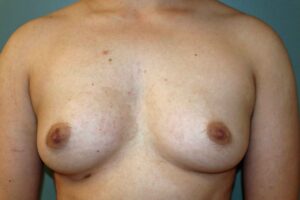
A) Before FTN top surgery
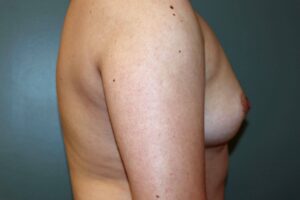
B) Before FTN top surgery
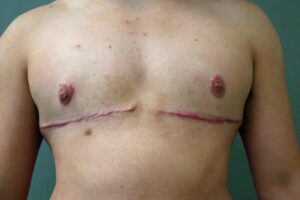
C) Thick scars from working out too soon following FTN top surgery
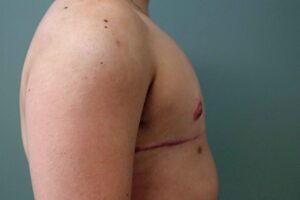
D) Thick scars from working out too soon following FTN top surgery
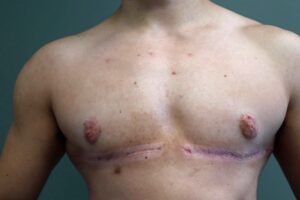
E) 6 months following scar revision and radiation treatments
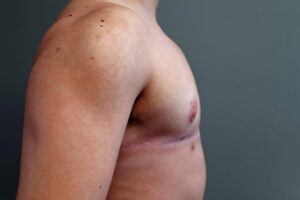
F) 6 months following scar revision and radiation treatments
When Should You Ideally Return to a Physically Demanding Job?
If you want to maximize the odds of having the best possible scar, everything else being equal, then based on the science, you should wait 3 months before engaging in a physically demanding job. Returning to work earlier than this will increase your risks for less desirable scarring of your chest.
Some common examples of physically demanding jobs that will impact FTM and FTN top surgery results include:
- Working in a warehouse at Amazon (or elsewhere)
- Being a stocker at a store
- Working as a barista at Starbucks or other coffee bar
- Doing construction
- Landscaping
- Being a server or cook at a restaurant
- Electrician
Your FTM or FTN Top Surgery Consultation
If you are ready to proceed with gender affirming top surgery and would like to have a consultation with me, Dr. Turkeltaub, you can schedule one either by calling the Arizona Center for Aesthetic Plastic Surgery at (480) 451-3000 or by contacting us via email.
Steven H. Turkeltaub, M.D. P.C.
Scottsdale and Phoenix, Arizona






